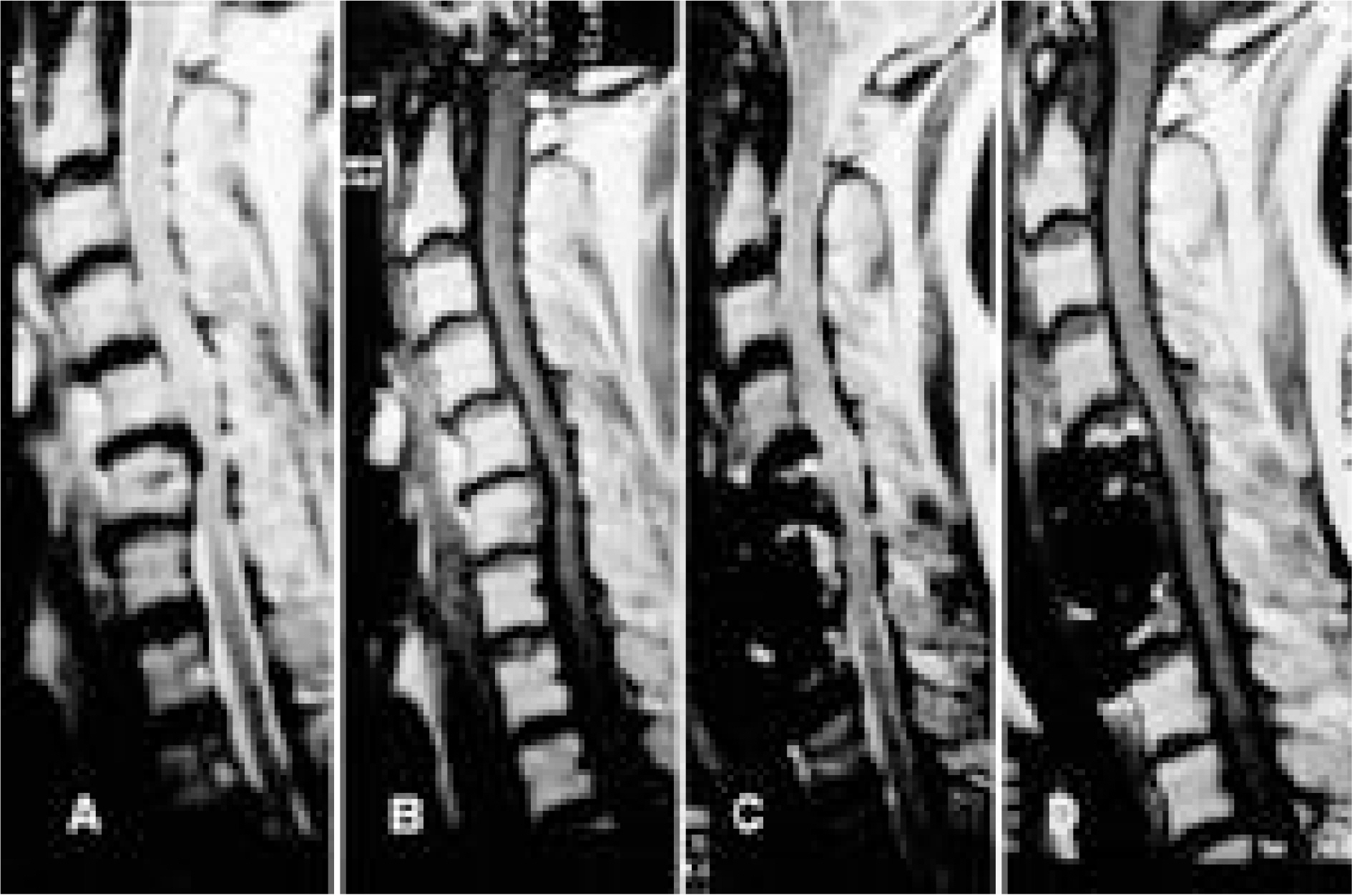J Korean Soc Spine Surg.
2001 Mar;8(1):68-73.
Outcome Analysis of Cervical Myelopathy in Patients More Than 70 Years of Age
- Affiliations
-
- 1Department of Orthopaedic Surgery, Kang-Dong Sacred Heart Hospital, College of Medicine, Hallym University, Seoul, Korea. skw@www.hallym.or.kr
Abstract
-
STUDY DESIGN: A retrospective study.
OBJECTIVES
To evaluate the surgical outcomes and image by mid-sagittal MRI in patients with cervical myelopathy who were more than 70 years of age. SUMMARY OF LITERATURE REVIEW: Surgical outcomes of cervical myelopathy in the elderly patients were worse than in the younger patients, but decompression surgery is helpful for improving neurologic function in the elderly.
MATERIALS AND METHODS
Nine patients more than 70 years of age who underwent surgery were reviewed. Neurologic deficits after surgery were assessed using a scoring system proposed by Japanese Orthopaedic Association( JOA ) and clinical results and morphological changes on MRI were compared with those of patients less than 70 years old age.
RESULTS
The preoperative mean JOA score was 8.5 and the postoperative mean JOA score 12.8 and the maximum recovery rate was 51.1%, but these were significantly inferior to scores in those less than 70 years of age. At the time of final follow up , the mean JOA score had decreased 11.3 and the recovery rate was 32.6%. All patients except one were improved their daily living function. On the postoperative midline T1 sagittal MRI, morphological improvement was seen in 44% in patients more than 70 years of age, while 69% of patients were improved in the control group.
CONCLUSIONS
Surgical decompression appears to be necessary as soon as possible after the onset of progressive myelopathy in the elderly patients for improving neurologic function and ability to engage in daily living.
Keyword
MeSH Terms
Figure
Reference
-
1). Bernhardt M, Hynes RA, Blume HW and White AA III. Current concept review: Cervical spondylotic myelopathy. J Bone Joint Surg [Am]. 75:119–128. 1993.2). Harada A and Mimatsu K. Postoperative changes in the spinal cord in cervical myelopathy demonstrated by magnetic resonance imaging. Spine. 17:1275–1280. 1992.3). Kawamura Y, Watanabe S, Takagi K and Takahashi Y. The morphometry of anterior horn cell bodies of spinal cord of man. Morphological changes of alpha and gamma motoneurons with age. Clin Neurol. 19:504–510. 1979.4). Law MD, Bernhardt M and White AA III. Evaluation and management of cervical spondylotic myelopathy. J Bone Joint Surg [Am]. 76:487–493. 1994.
Article5). Machada H, et al. A study of surgical treatment of cervical myelopathy and its complications on old aged patient. J West Jap Research Society for Spine. 12:136–139. 1986.6). Makino M, Mimatsu K, Saito H, Konishi N and Hashizume Y. Morphometric study of myelinated fibers in human cervical spinal cord white matter. Spine. 21:1010–1016. 1996.
Article7). Nagata K, et al. Clinical value of magnetic resonance imaging for cervical myelopathy. Spine. 15:1088–1096. 1990.
Article8). Nagata K, Ohashi T, Abe J, Morita M and Inoue A. Cervical myelopathy in elderly patients: Clinical results and MRI findings before and after decompression surgery. Spinal Cord. 34:220–226. 1996.
Article9). Takada S. The follow-up study on cervical osteochondro -sis &cervico-omobrachialgia(Non-operative cases). Cent Jpn J Orthop Trauma. 18:1–17. 1975.10). Tera S, Sobue G, Hashizume Y, Shimada N and Mitsuma T. Age-related changes of the myelinated fibers in the human corticospinal tract: A quantitative analysis. Acta Neuropathol. 88:137–142. 1994.
Article11). Tera S, Sobue G, Hashizume Y, Li M, Inagaki T and Mitsuma T. Age-related changes in human spinal ventral horn cells with special reference to the loss of small neu -rons in the intermediate zone: A quantitative analysis. Acta Neuropathol. 92:109–114. 1996.12). Zhang C, Goto N and Zhou M. Morphometric analysis and aging process of nerve fibers in the human posterior funiculus. Okajima Folia Anat jpn. 72:259–264. 1995.13). Zilger JE, Capen DA and Rothman SL. Spinal diseases in the aged. Clin Orthop. 316:70–79. 1995.
- Full Text Links
- Actions
-
Cited
- CITED
-
- Close
- Share
- Similar articles
-
- Guillain-Barre Syndrome Combined with Acute Cervical Myelopathy
- Surgical Outcome in Patients with Cervical Compression Myelopathy: A Study Using Magnetic Resonance Imaging
- Does Segmental Kyphosis Affect Surgical Outcome after a Posterior Decompressive Laminectomy in Multisegmental Cervical Spondylotic Myelopathy?
- Prognostic Factors Affecting the Surgical Outcome of the Cervical Myelopathy
- Malunion of the Odontoid Process Developing Cervical Myelopathy: A Case Report








